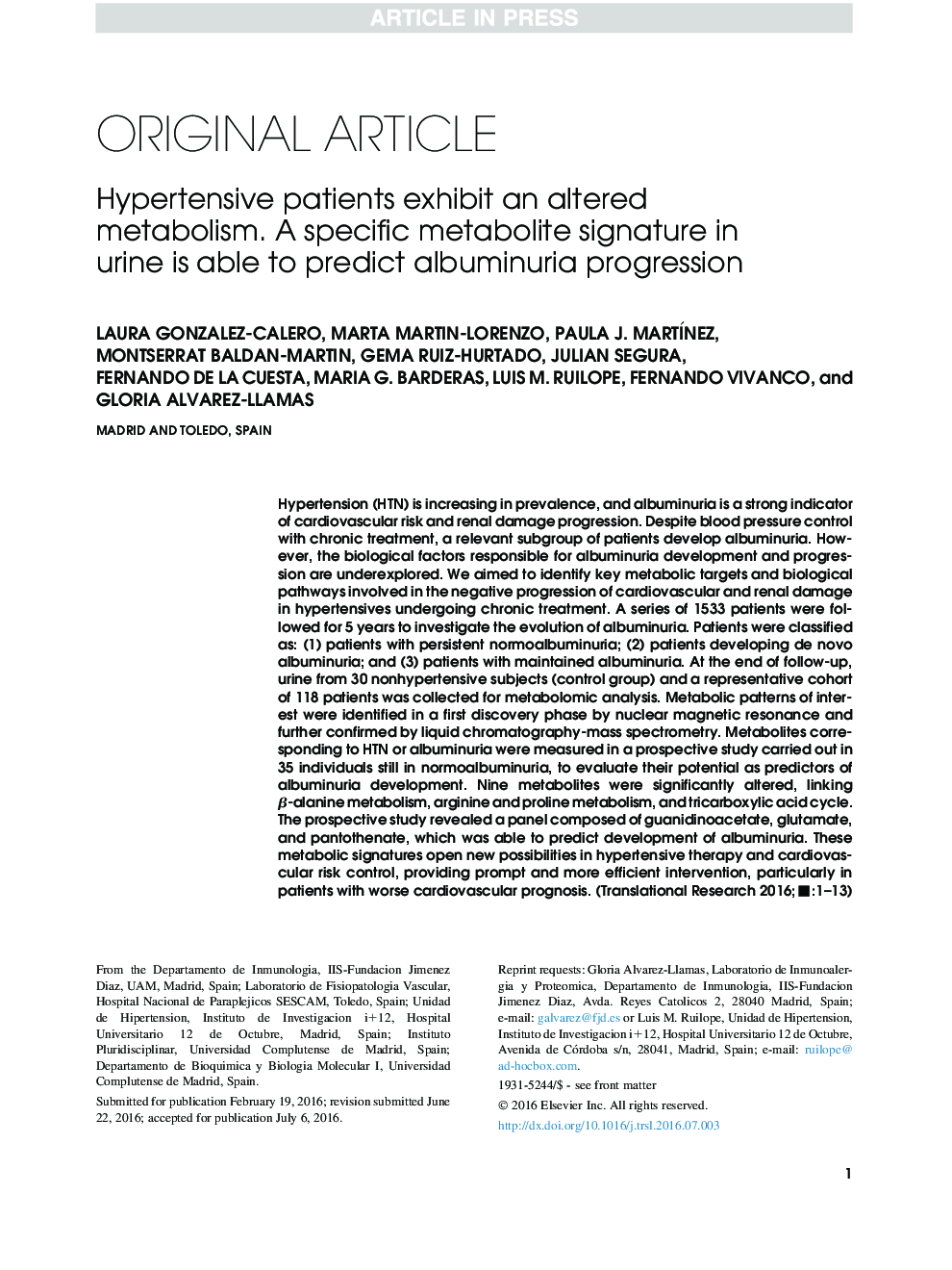| کد مقاله | کد نشریه | سال انتشار | مقاله انگلیسی | نسخه تمام متن |
|---|---|---|---|---|
| 5685114 | 1597932 | 2016 | 20 صفحه PDF | دانلود رایگان |
عنوان انگلیسی مقاله ISI
Hypertensive patients exhibit an altered metabolism. A specific metabolite signature in urine is able to predict albuminuria progression
ترجمه فارسی عنوان
بیماران مبتلا به فشار خون بالا متابولیسم تغییر یافته را نشان می دهند. امضای متابولیت خاص در ادرار قادر به پیش بینی پیشرفت آلبومینوری است
دانلود مقاله + سفارش ترجمه
دانلود مقاله ISI انگلیسی
رایگان برای ایرانیان
کلمات کلیدی
HTNHMDBARBACRSRMEGFRMHAROCRASHDLTSPnuclear magnetic resonance - رزونانس مغناطیسی هستهایAUC - AUCDNA - DNA یا اسید دزوکسی ریبونوکلئیکLC-MS/MS - LC-MS / MSalbumin to creatinine ratio - آلبومین به نسبت کراتینینAngiotensin converting enzyme inhibitors - آنژیوتانسین بازدارنده آنزیم تبدیل شده استNMR - تشدید مغناطیسی هستهای renin-angiotensin system - سیستم رنین-آنژیوتانسینbody mass index - شاخص توده بدنBMI - شاخص توده بدنیHypertension - فشار خون بالاBlood pressure - فشارخونhigh-density lipoprotein cholesterol - لیپوپروتئین پرچگالی یا اچدیالLDL - لیپوپروتئین کم چگالی(کلسترول بد)Angiotensin receptor blockers - مسدود کننده های گیرنده آنژیوتانسینarea under the curve - منطقه تحت منحنیACEI یا angiotensin convert enzyme inhibitor - مهارکننده آنزیم تبدیلکننده آنژیوتانسینestimated glomerular filtration rate - میزان تصفیه گلومرولی برآورد شده استselected reaction monitoring - نظارت بر واکنش انتخاب شدهNormoalbuminuria - نورمبلمینگوریاhuman metabolome database - پایگاه داده متابولیسم انسانserum creatinine - کراتینین سرمLow-density lipoprotein cholesterol - کلسترول لیپوپروتئین با چگالی کمreceiver operating characteristic - گیرنده عامل عاملSCR - یکسوساز کنترلشده با سیلیکون
موضوعات مرتبط
علوم پزشکی و سلامت
پزشکی و دندانپزشکی
پزشکی و دندانپزشکی (عمومی)
چکیده انگلیسی
Hypertension (HTN) is increasing in prevalence, and albuminuria is a strong indicator of cardiovascular risk and renal damage progression. Despite blood pressure control with chronic treatment, a relevant subgroup of patients develop albuminuria. However, the biological factors responsible for albuminuria development and progression are underexplored. We aimed to identify key metabolic targets and biological pathways involved in the negative progression of cardiovascular and renal damage in hypertensives undergoing chronic treatment. A series of 1533 patients were followed for 5 years to investigate the evolution of albuminuria. Patients were classified as: (1) patients with persistent normoalbuminuria; (2) patients developing de novo albuminuria; and (3) patients with maintained albuminuria. At the end of follow-up, urine from 30 nonhypertensive subjects (control group) and a representative cohort of 118 patients was collected for metabolomic analysis. Metabolic patterns of interest were identified in a first discovery phase by nuclear magnetic resonance and further confirmed by liquid chromatography-mass spectrometry. Metabolites corresponding to HTN or albuminuria were measured in a prospective study carried out in 35 individuals still in normoalbuminuria, to evaluate their potential as predictors of albuminuria development. Nine metabolites were significantly altered, linking β-alanine metabolism, arginine and proline metabolism, and tricarboxylic acid cycle. The prospective study revealed a panel composed of guanidinoacetate, glutamate, and pantothenate, which was able to predict development of albuminuria. These metabolic signatures open new possibilities in hypertensive therapy and cardiovascular risk control, providing prompt and more efficient intervention, particularly in patients with worse cardiovascular prognosis.
ناشر
Database: Elsevier - ScienceDirect (ساینس دایرکت)
Journal: Translational Research - Volume 178, December 2016, Pages 25-37.e7
Journal: Translational Research - Volume 178, December 2016, Pages 25-37.e7
نویسندگان
Laura Gonzalez-Calero, Marta Martin-Lorenzo, Paula J. MartÃnez, Montserrat Baldan-Martin, Gema Ruiz-Hurtado, Julian Segura, Fernando de la Cuesta, Maria G. Barderas, Luis M. Ruilope, Fernando Vivanco, Gloria Alvarez-Llamas,
